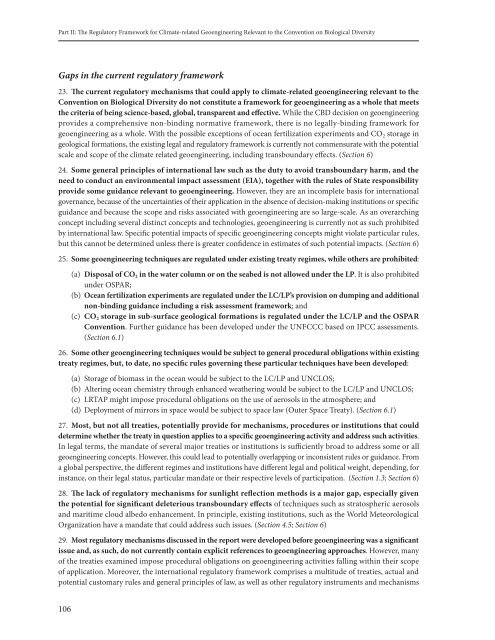cbd-ts-66-en
cbd-ts-66-en
cbd-ts-66-en
You also want an ePaper? Increase the reach of your titles
YUMPU automatically turns print PDFs into web optimized ePapers that Google loves.
Part II: The Regulatory Framework for Climate-related Geo<strong>en</strong>gineering Relevant to the Conv<strong>en</strong>tion on Biological Diversity<br />
Gaps in the curr<strong>en</strong>t regulatory framework<br />
23. The curr<strong>en</strong>t regulatory mechanisms that could apply to climate-related geo<strong>en</strong>gineering relevant to the<br />
Conv<strong>en</strong>tion on Biological Diversity do not constitute a framework for geo<strong>en</strong>gineering as a whole that mee<strong>ts</strong><br />
the criteria of being sci<strong>en</strong>ce-based, global, transpar<strong>en</strong>t and effective. While the CBD decision on geo<strong>en</strong>gineering<br />
provides a compreh<strong>en</strong>sive non-binding normative framework, there is no legally-binding framework for<br />
geo<strong>en</strong>gineering as a whole. With the possible exceptions of ocean fertilization experim<strong>en</strong><strong>ts</strong> and CO 2 storage in<br />
geological formations, the existing legal and regulatory framework is curr<strong>en</strong>tly not comm<strong>en</strong>surate with the pot<strong>en</strong>tial<br />
scale and scope of the climate related geo<strong>en</strong>gineering, including transboundary effec<strong>ts</strong>. (Section 6)<br />
24. Some g<strong>en</strong>eral principles of international law such as the duty to avoid transboundary harm, and the<br />
need to conduct an <strong>en</strong>vironm<strong>en</strong>tal impact assessm<strong>en</strong>t (EIA), together with the rules of State responsibility<br />
provide some guidance relevant to geo<strong>en</strong>gineering. However, they are an incomplete basis for international<br />
governance, because of the uncertainties of their application in the abs<strong>en</strong>ce of decision-making institutions or specific<br />
guidance and because the scope and risks associated with geo<strong>en</strong>gineering are so large-scale. As an overarching<br />
concept including several distinct concep<strong>ts</strong> and technologies, geo<strong>en</strong>gineering is curr<strong>en</strong>tly not as such prohibited<br />
by international law. Specific pot<strong>en</strong>tial impac<strong>ts</strong> of specific geo<strong>en</strong>gineering concep<strong>ts</strong> might violate particular rules,<br />
but this cannot be determined unless there is greater confid<strong>en</strong>ce in estimates of such pot<strong>en</strong>tial impac<strong>ts</strong>. (Section 6)<br />
25. Some geo<strong>en</strong>gineering techniques are regulated under existing treaty regimes, while others are prohibited:<br />
106<br />
(a) Disposal of CO 2 in the water column or on the seabed is not allowed under the LP. It is also prohibited<br />
under OSPAR;<br />
(b) Ocean fertilization experim<strong>en</strong><strong>ts</strong> are regulated under the LC/LP’s provision on dumping and additional<br />
non-binding guidance including a risk assessm<strong>en</strong>t framework; and<br />
(c) CO 2 storage in sub-surface geological formations is regulated under the LC/LP and the OSPAR<br />
Conv<strong>en</strong>tion. Further guidance has be<strong>en</strong> developed under the UNFCCC based on IPCC assessm<strong>en</strong><strong>ts</strong>.<br />
(Section 6.1)<br />
26. Some other geo<strong>en</strong>gineering techniques would be subject to g<strong>en</strong>eral procedural obligations within existing<br />
treaty regimes, but, to date, no specific rules governing these particular techniques have be<strong>en</strong> developed:<br />
(a) Storage of biomass in the ocean would be subject to the LC/LP and UNCLOS;<br />
(b) Altering ocean chemistry through <strong>en</strong>hanced weathering would be subject to the LC/LP and UNCLOS;<br />
(c) LRTAP might impose procedural obligations on the use of aerosols in the atmosphere; and<br />
(d) Deploym<strong>en</strong>t of mirrors in space would be subject to space law (Outer Space Treaty). (Section 6.1)<br />
27. Most, but not all treaties, pot<strong>en</strong>tially provide for mechanisms, procedures or institutions that could<br />
determine whether the treaty in question applies to a specific geo<strong>en</strong>gineering activity and address such activities.<br />
In legal terms, the mandate of several major treaties or institutions is suffici<strong>en</strong>tly broad to address some or all<br />
geo<strong>en</strong>gineering concep<strong>ts</strong>. However, this could lead to pot<strong>en</strong>tially overlapping or inconsist<strong>en</strong>t rules or guidance. From<br />
a global perspective, the differ<strong>en</strong>t regimes and institutions have differ<strong>en</strong>t legal and political weight, dep<strong>en</strong>ding, for<br />
instance, on their legal status, particular mandate or their respective levels of participation. (Section 1.3; Section 6)<br />
28. The lack of regulatory mechanisms for sunlight reflection methods is a major gap, especially giv<strong>en</strong><br />
the pot<strong>en</strong>tial for significant deleterious transboundary effec<strong>ts</strong> of techniques such as stratospheric aerosols<br />
and maritime cloud albedo <strong>en</strong>hancem<strong>en</strong>t. In principle, existing institutions, such as the World Meteorological<br />
Organization have a mandate that could address such issues. (Section 4.5; Section 6)<br />
29. Most regulatory mechanisms discussed in the report were developed before geo<strong>en</strong>gineering was a significant<br />
issue and, as such, do not curr<strong>en</strong>tly contain explicit refer<strong>en</strong>ces to geo<strong>en</strong>gineering approaches. However, many<br />
of the treaties examined impose procedural obligations on geo<strong>en</strong>gineering activities falling within their scope<br />
of application. Moreover, the international regulatory framework comprises a multitude of treaties, actual and<br />
pot<strong>en</strong>tial customary rules and g<strong>en</strong>eral principles of law, as well as other regulatory instrum<strong>en</strong><strong>ts</strong> and mechanisms


